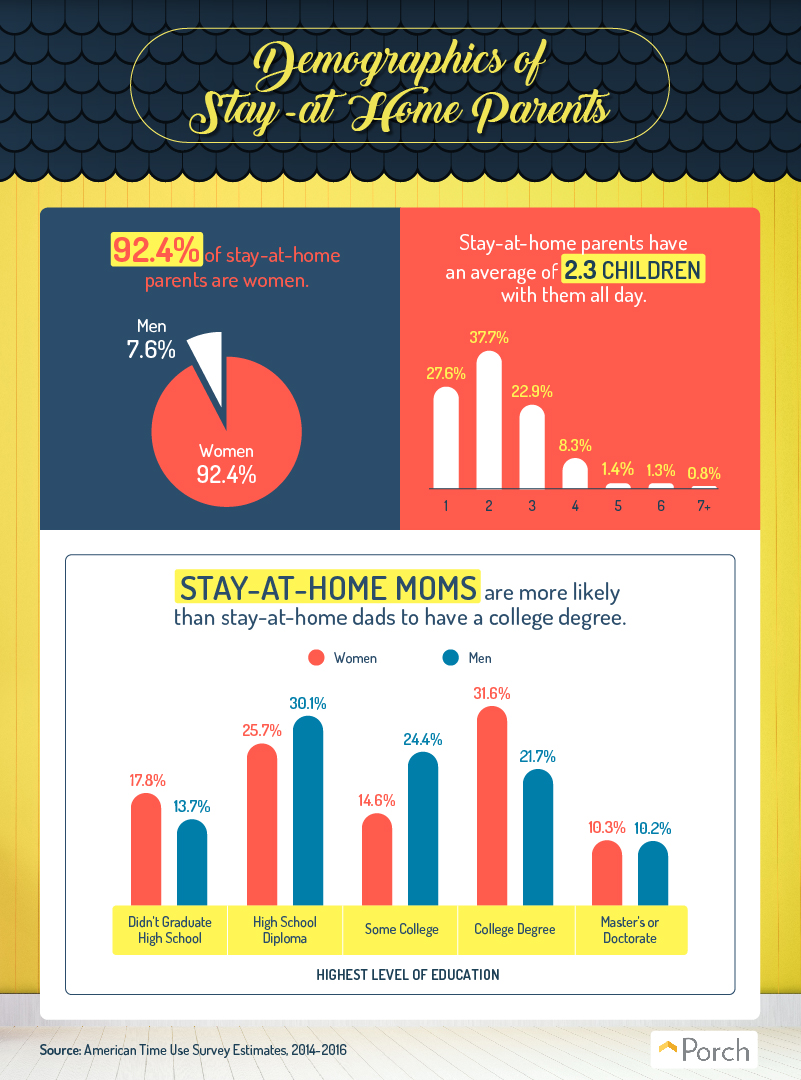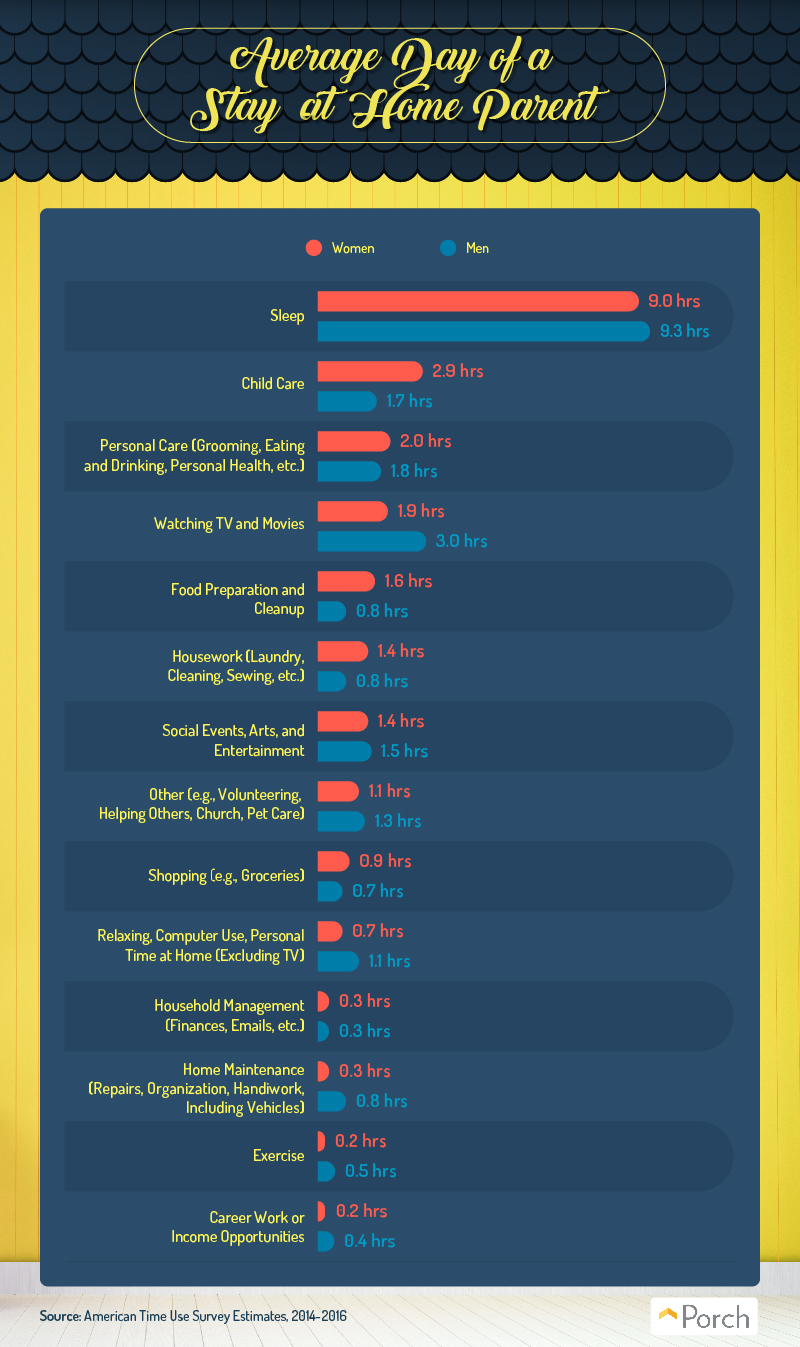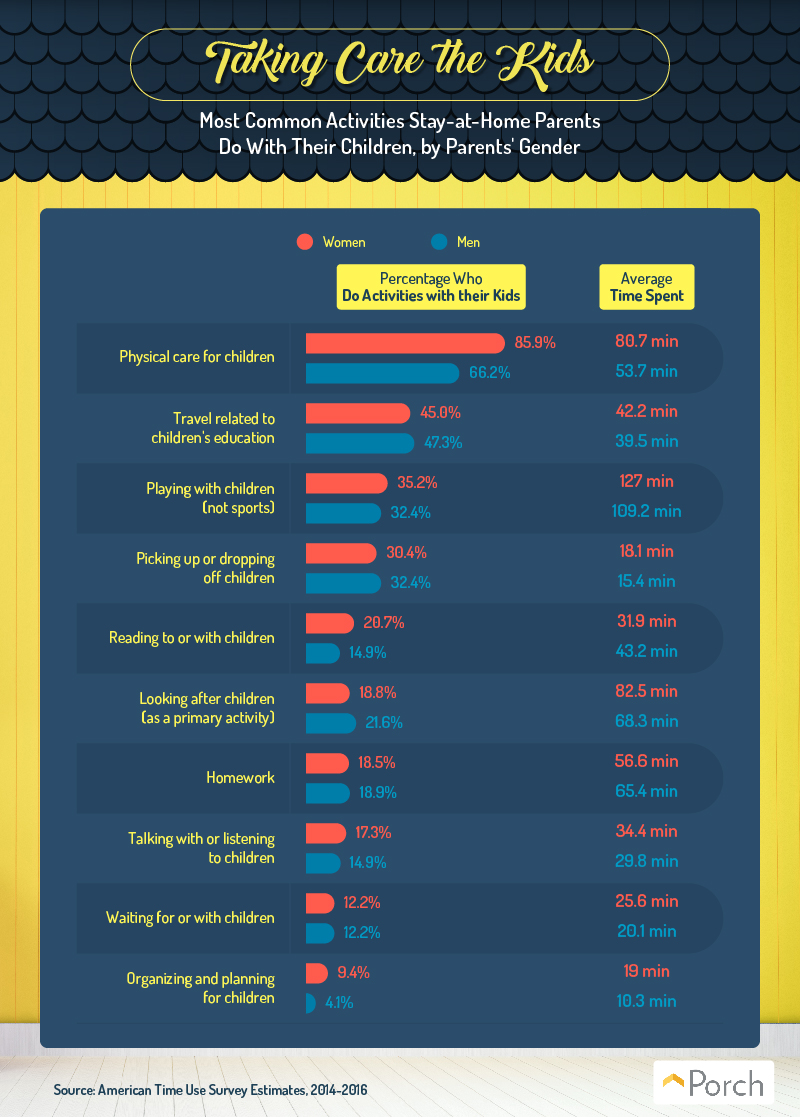
Among American families, stay-at-home parenting has had a quiet resurgence in recent years. Although female workforce participation climbed steadily during the 20th century, the last two decades have seen more moms choose full-time child care. Additionally, more fathers are foregoing careers to assume caregiving duties —and choosing this path willingly, not because they can’t find work. Experts attribute this trend to the costs of child care: As the price of quality care rises and wage growth remains largely stagnant, the incentive for both parents to work has declined. But today’s stay-at-home moms and dads aren’t just reviving the homemaking traditions of the 1950s. Many who stay at home are actively seeking something more, an ideal mix of parenting and personal fulfillment. We surveyed 1,000 stay-at-home parents and their spouses about their daily experiences, studying how they spend their time. We paired our findings with data from the American Time Use Survey for a comprehensive view of the stay-at-home lifestyle. From child care and chores to exercise and entertainment, we learned how these parents strive for balance—and how the schedules of men and women can differ dramatically. To understand what parenting at home is really like, keep reading.
Stats of staying at home
 First, we must clarify how we defined stay-at-home parents in the context of this project. Plenty of Americans work remotely these days, so staying at home and pursuing a career aren’t mutually exclusive. For our analysis, we focused on parents who had no regular employment, lived with an employed partner, and had at least one child aged 18 or younger. Of those who met these criteria in the American Time Use Survey data, more than 92 percent were women. Clearly, staying at home remains a largely feminine phenomenon, although recent research suggests many fathers envy stay-at-home dads’ ability to spend time with their kids. Interestingly, stay-at-home moms were more likely to possess a bachelor’s degree than their male counterparts. Two related trends may explain this finding: Women are more likely than men to attend college, and well-educated women are having children at much higher rates than in decades past. Whichever degree you possess, however, nothing quite prepares you for a household full of children. Although most stay-at-home parents reported caring for one or two kids each day, roughly a third looked after three or more children at once.
First, we must clarify how we defined stay-at-home parents in the context of this project. Plenty of Americans work remotely these days, so staying at home and pursuing a career aren’t mutually exclusive. For our analysis, we focused on parents who had no regular employment, lived with an employed partner, and had at least one child aged 18 or younger. Of those who met these criteria in the American Time Use Survey data, more than 92 percent were women. Clearly, staying at home remains a largely feminine phenomenon, although recent research suggests many fathers envy stay-at-home dads’ ability to spend time with their kids. Interestingly, stay-at-home moms were more likely to possess a bachelor’s degree than their male counterparts. Two related trends may explain this finding: Women are more likely than men to attend college, and well-educated women are having children at much higher rates than in decades past. Whichever degree you possess, however, nothing quite prepares you for a household full of children. Although most stay-at-home parents reported caring for one or two kids each day, roughly a third looked after three or more children at once.
Daily duties
 According to our analysis of the latest American Time Use Survey data, stay-at-home parents are getting plenty of sleep compared to the average American’s 6.8 hours nightly. Given their other responsibilities, however, they may need every bit of that rest. Women spent nearly three hours each day engaged in child care, and men spent more than an hour and a half on such tasks. Culinary prep and cleanup occupied a solid chunk of time as well, as did other household tasks such as cleaning and doing laundry. Thankfully, stay-at-home parents did have outlets to unwind as well: Moms and dads spent more than an hour each day on social or cultural events. They also indulged in TV and movies for a significant amount of time—although it’s impossible to know how much of that content was selected by their kids. But in terms of the effort and enjoyment of stay-at-home parents, our findings suggest a definite trend: Women seem to be doing more work and having less fun at home.
According to our analysis of the latest American Time Use Survey data, stay-at-home parents are getting plenty of sleep compared to the average American’s 6.8 hours nightly. Given their other responsibilities, however, they may need every bit of that rest. Women spent nearly three hours each day engaged in child care, and men spent more than an hour and a half on such tasks. Culinary prep and cleanup occupied a solid chunk of time as well, as did other household tasks such as cleaning and doing laundry. Thankfully, stay-at-home parents did have outlets to unwind as well: Moms and dads spent more than an hour each day on social or cultural events. They also indulged in TV and movies for a significant amount of time—although it’s impossible to know how much of that content was selected by their kids. But in terms of the effort and enjoyment of stay-at-home parents, our findings suggest a definite trend: Women seem to be doing more work and having less fun at home.
At-home inequality?
 Compared to their female peers, stay-at-home dads spent significantly less time on child care and household chores. Recent studies have observed a similar pattern in other countries, but the disparity evident in our data is startling. Stay-at-home moms spent 77 minutes more time taking care of the kids and 48 minutes more time on culinary tasks. The difference in housework effort was nearly as severe: Men spent nearly 38 minutes less time on obligations such as cleaning and laundry. Stay-at-home dads did devote more time to many activities, but most of them were leisure pursuits. Fathers took more personal time to relax and spent 65 minutes more time watching TV and movies. Dads did spend more time than moms on a couple of productive tasks: home repairs and small income opportunities. These findings suggest that stereotypical gender roles may still exert some influence over stay-at-home parents’ behaviors, even when dad is the one choosing to stay home
Compared to their female peers, stay-at-home dads spent significantly less time on child care and household chores. Recent studies have observed a similar pattern in other countries, but the disparity evident in our data is startling. Stay-at-home moms spent 77 minutes more time taking care of the kids and 48 minutes more time on culinary tasks. The difference in housework effort was nearly as severe: Men spent nearly 38 minutes less time on obligations such as cleaning and laundry. Stay-at-home dads did devote more time to many activities, but most of them were leisure pursuits. Fathers took more personal time to relax and spent 65 minutes more time watching TV and movies. Dads did spend more time than moms on a couple of productive tasks: home repairs and small income opportunities. These findings suggest that stereotypical gender roles may still exert some influence over stay-at-home parents’ behaviors, even when dad is the one choosing to stay home
Tallying the tasks
 Our data indicate stay-at-home moms tend to shoulder a greater burden than stay-at-home dads, but how do they perceive their workloads relative to that of their partners? Over two-thirds of stay-at-home moms suggested they did more chores than their spouses, whereas just 44 percent of stay-at-home dads made that claim. Indeed, dads who stayed home were more likely to say they split chores evenly with their partners—and roughly 1 in 5 admitted their partners actually did more. Some experts suggest a “specialization” strategy for couples tackling chores: Each person should focus on the tasks he or she does best, rather than sharing every duty. Our findings do suggest such a pattern, although it may reflect gender norms more than parents’ particular skills. A majority of stay-at-home dads claimed to do only two tasks more often than their spouses: mowing the lawn and taking out the trash. Meanwhile, at least 80 percent of stay-at-home moms said they did the following chores more often than their partners: cleaning floors, toilets, countertops, showers, and folding clothes.
Our data indicate stay-at-home moms tend to shoulder a greater burden than stay-at-home dads, but how do they perceive their workloads relative to that of their partners? Over two-thirds of stay-at-home moms suggested they did more chores than their spouses, whereas just 44 percent of stay-at-home dads made that claim. Indeed, dads who stayed home were more likely to say they split chores evenly with their partners—and roughly 1 in 5 admitted their partners actually did more. Some experts suggest a “specialization” strategy for couples tackling chores: Each person should focus on the tasks he or she does best, rather than sharing every duty. Our findings do suggest such a pattern, although it may reflect gender norms more than parents’ particular skills. A majority of stay-at-home dads claimed to do only two tasks more often than their spouses: mowing the lawn and taking out the trash. Meanwhile, at least 80 percent of stay-at-home moms said they did the following chores more often than their partners: cleaning floors, toilets, countertops, showers, and folding clothes.
Keeping up with the kids
 The chance to spend time with one’s children is a major benefit of staying at home. But according to our data, a surprising percentage of stay-at-home parents skipped common child care activities. Roughly 4 in 5 stay-at-home moms and dads did not read to their children or help them with homework. These findings could have an innocuous explanation, however: Perhaps some evening duties are reserved for the working partner so that they can also share some special time with the kids. Stay-at-home parents were typically more engaged with regard to their children’s physical needs, with only 14 percent of stay-at-home moms and 33 percent of stay-at-home dads not performing these duties. And although more than half of stay-at-home moms and dads did not participate in getting their children to school, perhaps they relied on school buses instead.
The chance to spend time with one’s children is a major benefit of staying at home. But according to our data, a surprising percentage of stay-at-home parents skipped common child care activities. Roughly 4 in 5 stay-at-home moms and dads did not read to their children or help them with homework. These findings could have an innocuous explanation, however: Perhaps some evening duties are reserved for the working partner so that they can also share some special time with the kids. Stay-at-home parents were typically more engaged with regard to their children’s physical needs, with only 14 percent of stay-at-home moms and 33 percent of stay-at-home dads not performing these duties. And although more than half of stay-at-home moms and dads did not participate in getting their children to school, perhaps they relied on school buses instead.
Adequately appreciated?
 Spouses of stay-at-home parents felt they were appropriately grateful for their partners’ efforts. Fortunately, most stay-at-home parents agreed, with 80 percent of dads and 72 percent of moms saying they felt appreciated. In fact, spouses of stay-at-home parents were more likely to admit their partners had the harder day-to-day grind. Perhaps employed parents are more grateful for their partner’s work at home than most assume. Moreover, most spouses felt they should do more to help their partners who stayed home. Interestingly, though, over 13 percent of stay-at-home moms’ partners said they should actually be doing less. If our earlier results are any indication, however, stay-at-home moms are doing their fair share already—at least compared to the average stay-at-home dad. Counterintuitively, less than 5 percent of stay-at-home dads’ spouses felt they deserved to do less around the house.
Spouses of stay-at-home parents felt they were appropriately grateful for their partners’ efforts. Fortunately, most stay-at-home parents agreed, with 80 percent of dads and 72 percent of moms saying they felt appreciated. In fact, spouses of stay-at-home parents were more likely to admit their partners had the harder day-to-day grind. Perhaps employed parents are more grateful for their partner’s work at home than most assume. Moreover, most spouses felt they should do more to help their partners who stayed home. Interestingly, though, over 13 percent of stay-at-home moms’ partners said they should actually be doing less. If our earlier results are any indication, however, stay-at-home moms are doing their fair share already—at least compared to the average stay-at-home dad. Counterintuitively, less than 5 percent of stay-at-home dads’ spouses felt they deserved to do less around the house.
A house worth staying in—or coming home to
As our results make undeniably clear, stay-at-home parenting can include a tough slate of tasks. Domestic duties and child care can be completely consuming, no matter the parent’s gender. However they choose to contribute to family life, we hope parents can pause to take pride in all that they do already. Whether they work or stay home, supporting a happy and healthy family is no small challenge. Parents experience countless joys and sacrifices, whichever roles they assume. If you’re busy with chores and child care, let Porch take a few tasks off your plate. We help you find home improvement pros in your area, with background checks and reviews included. We can help you with large projects like replacing your windows or small projects like putting in a new dishwasher. Plus, our helpful project cost guides can help you keep your budget under control. Sometimes, you don’t have to DIY—you do enough yourself already.
Methodology
To find out more about the lives of stay-at-home moms and dads, we collected data from the American Time Use Survey from 2014 to 2016. Because there is no standardized definition of a stay-at-home parent, we identified stay-at-home parents as parents of children under 18 living at home who are not currently employed but have a partner employed full time. This is a somewhat narrow definition, as it does not include parents who work part time or work at home while simultaneously watching children. We then supplemented the Time Use data with our own survey, collected using Amazon’s Mechanical Turk. Our survey respondents consisted of 739 stay-at-home parents and 261 spouses of stay-at-home parents. Of the stay-at-home parents, 78 percent were women, and of the spouses, 80 percent were men. Because answers were from survey participants, the survey relies on self-reported data.
Fair Use Statement
You’re free to use our findings and images in any noncommercial capacity. When you do, however, please link back to this page to attribute our team. Just like stay-at-home parents, we appreciate a little credit for our efforts.
